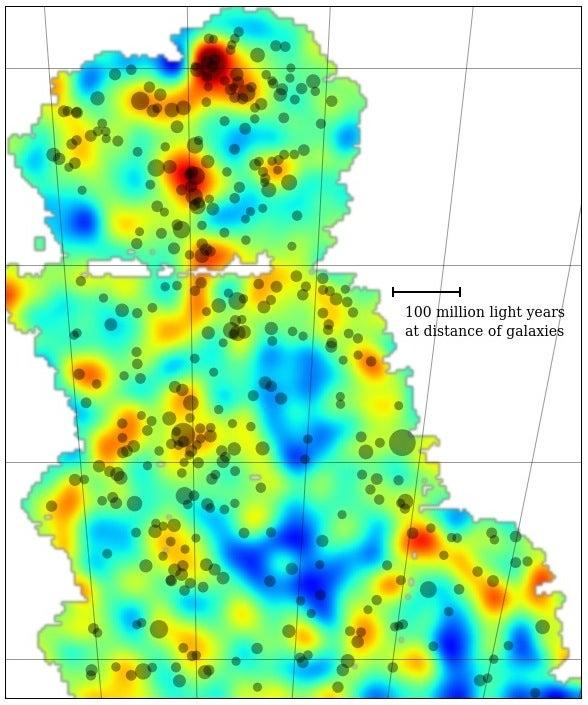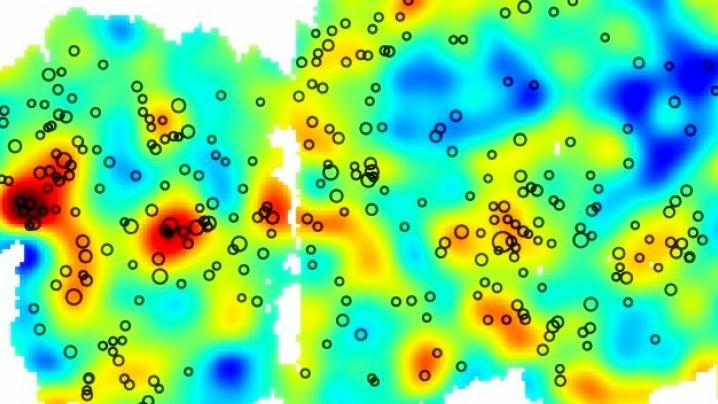Researchers Create a New Map of Invisible Dark Matter
Guide Could Be Key to Understanding the Evolution of the Universe
Scientists on the Dark Energy Survey, including researchers from the Department of Energy’s SLAC National Accelerator Laboratory, have released the first in a series of dark matter maps of the cosmos. These maps, created with one of the world’s most powerful digital cameras, are the largest contiguous maps created at this level of detail, and will improve our understanding of dark matter’s role in the formation of galaxies. They may also shed light on an unknown form of energy, called dark energy, which is believed to cause the universe to expand at an accelerating rate.
Dark matter, the mysterious substance that makes up roughly a quarter of the universe, is invisible to even the most sensitive astronomical instruments because it does not emit or block light. But it reveals itself in an effect known as gravitational lensing – the distortion that occurs when the gravitational pull of dark matter bends light around distant galaxies.
“Maps of these distortions tell us where dark matter is located in the universe,” said DES researcher Risa Wechsler from the Kavli Institute for Particle Astrophysics and Cosmology, a joint institute of SLAC and Stanford University. “But they reveal more than that. If we know how the distribution of dark matter has evolved over time, we’ll be able to learn something about dark energy, which is the ultimate goal of the DES research program.”
A Map of Dark Matter
The analysis team, led by Vinu Vikram of Argonne National Laboratory (formerly at the University of Pennsylvania) and former KIPAC graduate student Chihway Chang of ETH Zurich, Switzerland, worked for more than a year to carefully validate the lensing map that was released April 13 at a meeting of the American Physical Society in Baltimore, Maryland. The map was created using data captured by the 570-megapixel Dark Energy Camera, which is mounted on a telescope in Chile.
“We measured the barely perceptible distortions in the shapes of about two million galaxies,” Vikram said in a statement from Fermi National Accelerator Laboratory, which manages the international DES collaboration. “They are a testament not only to the sensitivity of the Dark Energy Camera, but also to the rigorous work by our lensing team to understand its sensitivity so well that we can get exacting results from it.”
The dark matter map makes use of early DES observations and covers only about 3 percent of the area of sky that DES will document over its five-year mission. The survey has just completed its second year. As scientists expand their search, they will be able to better test current cosmological theories by comparing the amounts of dark and visible matter.

Dark Matter and Galaxy Formation
Those theories suggest that, since there is about five times more dark matter in the universe than visible matter, galaxies will form where the concentration of dark matter is large and hence gravity is stronger.
So far, the DES analysis backs this up. The researchers generated an independent map of visible galaxies and compared it with the map of invisible dark matter. “In locations with a high density of dark matter, we find a large number of galaxy clusters,” said KIPAC’s Eli Rykoff, who developed an analysis tool that identifies these clusters in the DES data. “On the other hand, only a few galaxy clusters reside in cosmic voids that contain very little dark matter.”
Additional theoretical simulations performed by Wechsler’s group are in agreement with the experimental findings. “This study tests the key idea that the distribution of galaxies traces the distribution of matter in the universe over larger scales than previously possible,” Wechsler said.
Future studies using the enormous volume of data collected throughout the survey will reveal more about this interplay of mass and light. “Our analysis so far is in line with what the current picture of the universe predicts,” Chang said in Fermilab’s statement. “Zooming into the maps, we have measured how dark matter envelops galaxies of different types, and how together they evolve over cosmic time. We are eager to use the new data coming in to make much stricter tests of theoretical models.”
Editor’s note: This news feature is based on a press release by Fermilab.
For questions or comments, contact the SLAC Office of Communications at communications@slac.stanford.edu.
SLAC is a multi-program laboratory exploring frontier questions in photon science, astrophysics, particle physics and accelerator research. Located in Menlo Park, Calif., SLAC is operated by Stanford University for the U.S. Department of Energy's Office of Science.
SLAC National Accelerator Laboratory is supported by the Office of Science of the U.S. Department of Energy. The Office of Science is the single largest supporter of basic research in the physical sciences in the United States, and is working to address some of the most pressing challenges of our time. For more information, please visit science.energy.gov.






